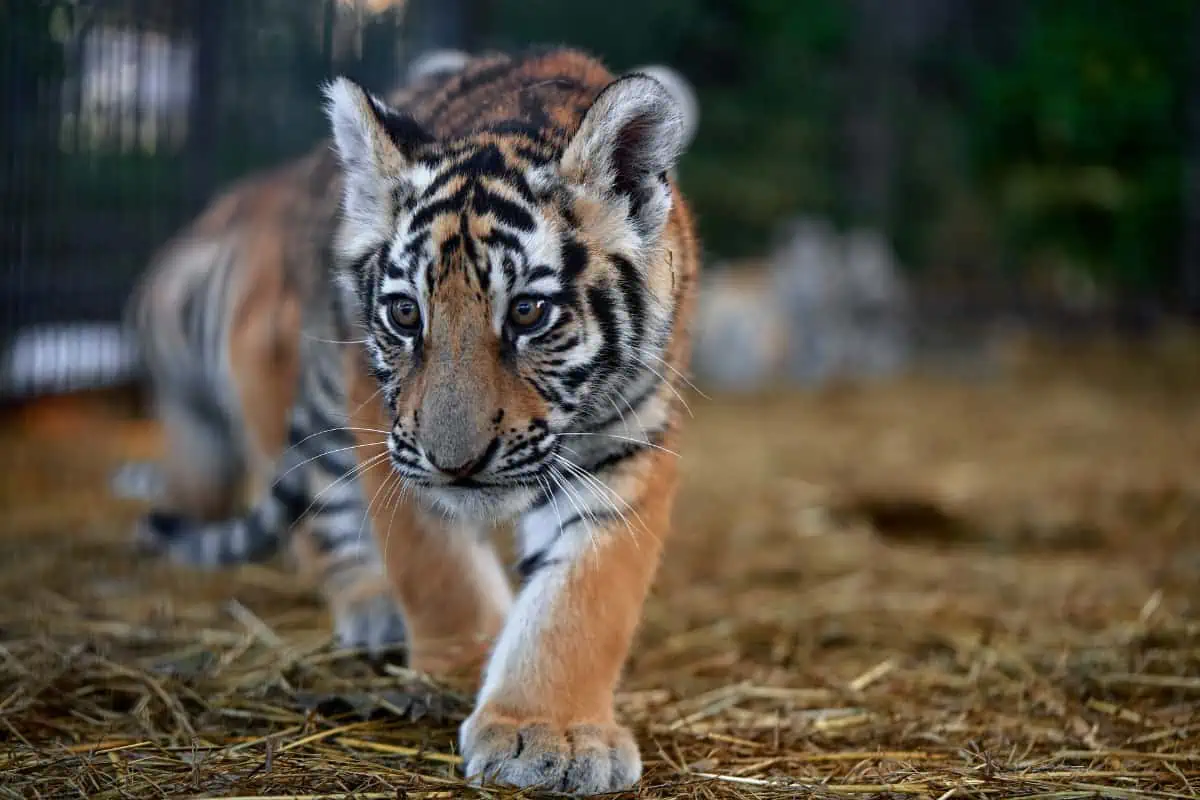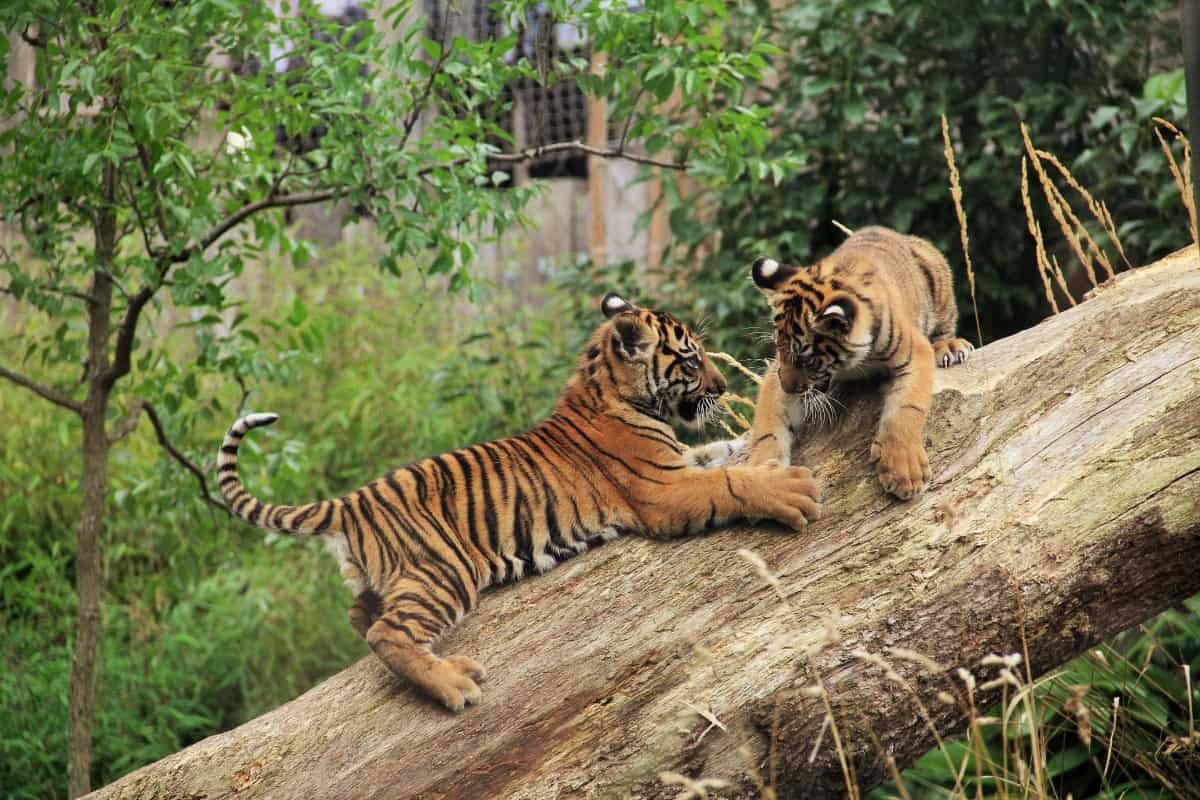A baby tiger, commonly known as a cub, is born weighing approximately 1.5 kilograms and is helpless for the first two weeks of its life.
Their rapid growth and developmental stages, from infancy to adulthood, are fascinating. Although these cubs may appear cute and cuddly, they soon become highly efficient and deadly predators.
This article will provide insight into baby tigers’ growth stages, behavior, and development in the wild.
The development of baby tigers:

Welcoming a Baby Tiger into the World
Tiger cubs are typically born during the months of March to June, with some births occurring in September.
These months are the most conducive for mating due to the favorable weather conditions. The gestation period for tigers is approximately 93 to 114 days or around 3 to 4 months.
Female tigers can become pregnant at least once a year.
Stages of Baby Tiger Development
The development of a baby tiger can be broken down into the following stages:
- Day 1 – Birth: Tiger cubs are born blind and helpless. They immediately seek a teat to suckle on and form a bond with their mother through her scent and grooming.
- Day 6 to Day 14 – Eyes Open: During this stage, tiger cubs gain the ability to see basic shapes but remain weak and dependent on their mother.
- Day 14 – Milk Teeth Emerge: This marks the beginning of a cub’s transition to solid food. They continue to suckle but will start chewing on objects to strengthen their milk teeth.
- 8 Weeks – Introduction to Meat: Cubs eat small pieces of meat from their mother’s prey. They are weaned off their mother’s milk by 5 to 6 months of age.
Growing Up Wild
Tiger cubs grow at an exponential rate within their first year. By 11 months, they start hunting alongside their mother, having honed their basic skills through play.
These playful sessions serve as training for their future hunting endeavors.
A dominant cub, usually a male, will lead the others in exploration.
The mother tiger spends six months to a year training her cubs to hunt properly. She will capture prey but allow her cubs to finish it so they learn the necessary skills.
Cubs become more independent at 18 to 20 months and will separate from their mother by 2 to 2.5 years.
They reach sexual maturity at 4 to 5 years for females and 5 to 6 years for males.
Tiger Development Stages Overview
| Stage | Age | Description |
|---|---|---|
| Birth | Day 1 | Born blind and helpless; immediately start suckling and bonding with their mother |
| Eyes Open | Day 6 to Day 14 | Gain the ability to see basic shapes; remain weak and dependent on their mother |
| Milk Teeth Emerge | Day 14 | Begin transitioning to solid food; continue to suckle and chew on objects to strengthen their teeth |
| Introduction to Meat | 8 weeks | Start eating small pieces of meat from their mother’s prey; weaned off milk by 5 to 6 months |
| Hunting and Play | 11 months | Begin hunting alongside their mother; hone their skills through play |
| Independence and Exploration | 18 to 20 months | Become more independent from their mother and start exploring their surroundings |
| Separation from Mother | 2 to 2.5 years | Voluntarily separate from their mother and seek their own territory |
| Sexual Maturity | 4 to 5 years (F) | Females reach sexual maturity |
| 5 to 6 years (M) | Males reach sexual maturity |
Weight and Litter Size
A baby tiger weighs between 780 to 1600 grams at birth and rapidly gains weight with the help of their mother’s milk.
Litter sizes typically consist of 2 to 3 cubs, with some litters having as many as 6 or 7 cubs.

Mother Tigers Raise the Cubs Alone
Female tigers are solely responsible for the rearing and raising of their young.
It is rare for adult male tigers to participate in cub-rearing, as they usually leave after mating.
Challenges Faced by Baby Tigers in the Wild
Baby tigers face numerous challenges in the wild, including:
1. Infanticide:
Adult male tigers, like lions, may kill unrelated cubs to induce the mother to enter heat. This poses a significant threat to the survival of young cubs.
2. Predation:
As they are defenseless during their early stages, baby tigers are susceptible to predation by other large predators such as leopards, hyenas, and crocodiles.
3. Sibling Rivalry:
Competition for food and attention from their mother can lead to conflicts among siblings, which may result in injury or death.
4. Disease and Parasites:
Baby tigers are vulnerable to various diseases and parasites, which may result in poor health, stunted growth, or even death.
Conservation Efforts
Several conservation efforts have been implemented to protect and preserve the tiger population:
1. Anti-poaching measures:
Governments and NGOs have established anti-poaching teams to curb the illegal killing of tigers for their skin, bones, and other body parts.
2. Habitat preservation:
Efforts have been made to secure and restore tiger habitats, ensuring they have access to adequate prey and space to roam.
3. Monitoring and research:
Researchers track tiger populations using camera traps, GPS collars, and other methods to gather crucial data on their distribution, behavior, and health.
This information aids in the development of effective conservation strategies.
4. Community involvement:
Conservation organizations collaborate with local communities to raise awareness about the importance of tigers and promote coexistence between humans and wildlife.
5. Captive breeding programs:
Some organizations have established captive breeding programs to maintain genetic diversity and, in some cases, reintroduce captive-born tigers into the wild.
Final Thoughts
Tigers, a majestic and endangered species, confront numerous challenges that jeopardize their existence in the wild. Baby tigers are particularly susceptible during their early stages of development, facing threats such as poaching, accidental trapping, habitat loss, and prey loss.
Despite their ability to mate year-round and produce sizable litters, these factors continue diminishing their numbers in the wild.
Through coordinated and dedicated conservation efforts, we can work together to bolster the tiger population and safeguard their future.
By doing so, we ensure that every tiger cub has the opportunity to reach its full potential and flourish both in the wild and in captivity.
